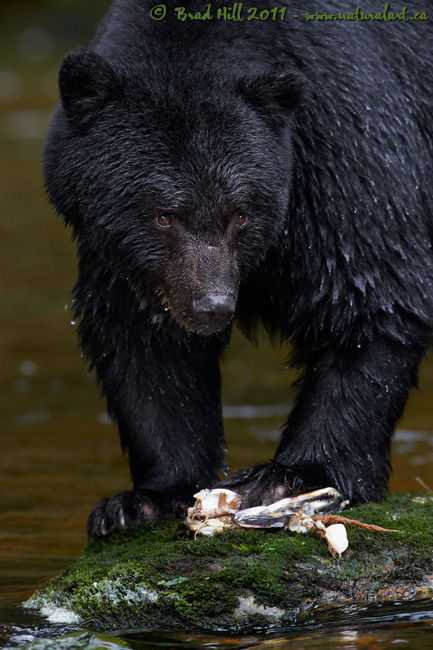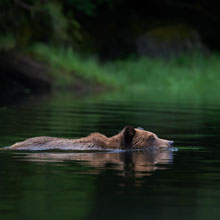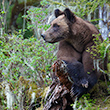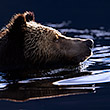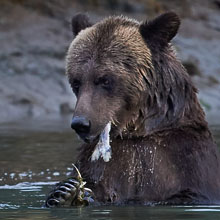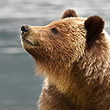Availability: Undetermined - Enquiries?
In the Field
Wet & Wary. Great Bear Rainforest (on northern BC Coast), BC, Canada. September 30, 2011.
I captured this image of a young Black Bear "checking out the competition" while feeding on a salmon carcass in a stream in the Great Bear Rainforest of BC in the early autumn of 2011. I've visited this same creek over the past few years and this bear looks very much like one I've seen a few times before. If it is the same bear it tends to get "kicked around" a lot by the older and larger bears and is, consequently, very wary of other bears (as can be seen by the look it's giving here towards a bear that's way upstream). Interestingly this guy is much less wary of humans and won't hesitate to go about "doing its thing" with humans nearby. In fact, this bear won't hesitate to "push" humans back a little (euphemistically speaking, of course) if they get in the way of its food. Though still on the small side, It's a bear you definitely want to show the proper respect for.
Bears do have individual and unique personalities that become quite apparent when you watch them for awhile. Some are bold, some are shy, others are inquisitive, and so on. Whenever possible I like to try to capture images of them that reflect their unique personalities, but it isn't always easy. And, if you're interesting in capturing photographs that have an impact on those who don't know the individual bear, it also means you have to capture that personality in a way that still has some general visual interest. The tough thing, though, is "distancing yourself" enough from your own emotional attachment to an image (or bear, or deer, or elk) to be able to judge if an image will be received well - and as intended - by others. For instance - I certainly think this image conveys "wariness", but I may be imposing my own knowledge and relationship with this bear on the image (and a non-invested individual simply wouldn't see it).
Following this line of thinking through to its logical conclusion quickly leads one to ask the question "who am I shooting my images for anyway?". It's a good question to ask. And the answer to that question can be critical to one's self esteem when they show their all-time favourite image to someone else (or post it on a website or on an image critiquing gallery) and it gets nothing more than a yawn! The real question is: Does the response of others even matter? If you're a professional the response obviously DOES matter, but if you are shooting as a hobby (like the vast majority of wildlife photographers do), then the most important person to please is definitely YOURSELF!
NOTE: This image was captured during one of my photo tours into a region of British Columbia known as "The Great Bear Rainforest". I offer both instructional photo tours and "photo op only" photo tours into the Great Bear Rainforest each spring and autumn. If you're interested in participating in one of these trips, just check out the Photo Tours page of this website!
Behind the Camera
Wet & Wary. Great Bear Rainforest (on northern BC Coast), BC, Canada. September 30, 2011.
Digital Capture; Compressed RAW (NEF) 14-bit format; ISO 2500.
Nikon D3s with Nikkor 600mm f4 VRII lens - supported on carbon fibre Gitzo 1348 tripod with Wimberley head. VR on and in "Normal" mode.
1/250s @ f5.6; -0.67 stop compensation from matrix-metered exposure setting.
At the Computer
Wet & Wary. Great Bear Rainforest (on northern BC Coast), BC, Canada. September 30, 2011.
RAW Conversion to 16-bit TIFF, including first-pass/capture sharpening using Phase One's Capture One Pro 6. Three exposure variants covering a 1.2 stop total range.
Further digital corrections on resulting 16-bit TIFF files using Adobe's Photoshop CS5 and Light Craft's LightZone. Photoshop adjustments including compositing (layering and masking) the exposure variants, selective colour desaturation, and selective sharpening for web output. Final contrast/tone tweaking - to head and leg regions of the bear - performed with LightZone using the tonemapper/re-light tool.
Conservation
Wet & Wary. Great Bear Rainforest (on northern BC Coast), BC, Canada. September 30, 2011.
Ten percent of the revenue generated by this image will be donated to Raincoast*.
Species Status in Canada**: Not currently listed as Threatened or Endangered.
This black bear is a member of the subspecies "Kermodei" (Ursus americana kermodei). This subspecies is unique in that the population is characterized by having an unusually high proportion of a recessive gene that produces white coat colour (found on the "Spirit Bears"). Because the Black Bear is not considered under threat as a species, both the Kermodei subspecies and the very rare Spirit Bear suffer from having the same conservation designation (it should be acknowledged that in British Columbia - the jurisdiction of greatest Spirit Bear abundance - hunting of these white-coated bears is not permitted). For reasons that are not fully understood, the Spirit Bear occurs with greater frequency in a relatively small geographic area within The Great Bear Rainforest of the central and northern coast of British Columbia. In this area 10 to 30% of the bears possess white coats. Many of the black-coloured Black Bears in this region carry the gene for white coats, so allowing hunting of ANY Black Bears in this region can reduce the frequency of the gene for white coats. Thus, to protect the Spirit Bear, it is necessary to prohibit the hunting of ALL Black Bears in this region. And, very unfortunately, the globally unique ecosystem that contains the Spirit Bear is under development pressure, especially from the forestry industry. If this unique environment is altered, we may lose the wonderful genetic anomaly known as the Spirit Bear forever.
*The Raincoast Conservation Society (and Foundation) is an effective and efficient organization that has been fighting for protection of this unique habitat. If you are looking for a meaningful way to contribute to the conservation of this amazing ecosystem, Raincoast will provide maximal "bang" for your conservation dollars.
**as determined by COSEWIC: The Committee on the Status of Endangered Wildlife in Canada












